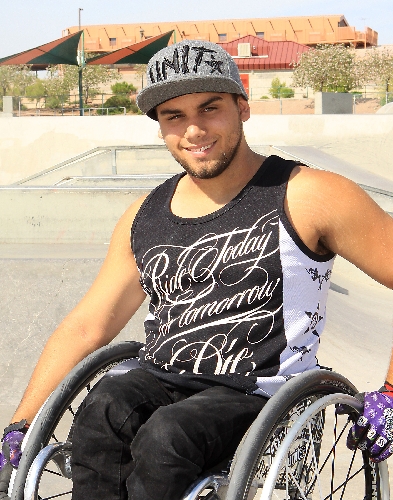With skate park moxie and BMX skill, wheelchair athlete inspires



Aaron Fotheringham is demonstrating some slick moves to a few guests at the Doc Romeo Park skate park.
He drops his wheelchair – that’s right, his wheelchair – in the bowl and veers right and then left, picking up speed and taking air over a rise before, careening on only one wheel, he rides up again to the top of the bowl.
Then he does it a few more times, changing his wheelchair choreography a little bit, until the photographer says he’s gotten all that he needs.
But Fotheringham suggests just one more run. He drops back in the bowl and does his lightning-fast array of moves, but this time he caps it off with a full-on flip – that’s one complete rotation in his wheelchair – before landing perfectly on the unforgivably hard concrete.
After his bystanders catch their respective breaths, it’s suggested to Fotheringham that maybe he could have prepared a guy for that heartbeat-stalling big finish.
Fotheringham – nickname Wheelz – smiles in that way kids who’ve just succeeded in scaring the bejabbers out of older people do, and explains that, if he did, somebody might’ve been tempted to look away.
“I just kind of like to surprise people,” he adds, punctuating the smile with an enjoying-this-way-too-much chuckle.
Call it showmanship. Call it confidence forged by years of practice. Call it wheelchair wizardry. But, whatever it is, it’s helped to transform Fotheringham from Las Vegas neighborhood skate park guy into an internationally known extreme sports hero.
“He’s known all over the world. He’s a rock star,” says Joe Wichert, community programs specialist for the city of Las Vegas’ parks and recreation department and former city extreme sports coordinator, who has known Fotheringham since his earliest wheelchair descents into a Las Vegas skate park bowl.
“No matter who I deal with, they always say, ‘Yeah, that kid in Vegas in the wheelchair, he’s part of your program,’ ” Wichert says. “They always know Aaron.”
Fotheringham, 20, is a pioneer in the still-developing sport of – as he prefers to call it – wheelchair MX or wheelchair motocross. Strapped into his heavy-duty, suspension-equipped wheelchair, Fotheringham performs jumps, one-wheeled turns, leaps, flips and other gravity- (and common sense-) defying feats on the same courses that skateboarders and BMX riders do.
That he’s using a wheelchair stems from Fotheringham’s having spina bifida, a birth defect in which the embryonic spinal column doesn’t develop properly. For Fotheringham, the result was a severe limitation in his ability to use his legs.
“I’m pretty much paralyzed but with feeling,” he explains. “Like, I can feel my toes perfectly, I just can’t wiggle them, which is weird.”
But none of that prevented Fotheringham – who was adopted by his parents, Kaylene and Steve Fotheringham, when he was 3 months old – from always having been a hyper (his description) and tenacious (his mom’s description) kid who loved “watching X Games and stuff.”
“When I was younger, I would just be a little daredevil, jumping my little hospital-issued wheelchair off the curb,” Fotheringham recalls. “And I had little wheelie bars, so I’d just stay in a wheelie, watching TV. Just having fun, like anyone else.”
And when friends hopped onto their bicycles to, maybe, make a minimart soda run, Fotheringham would lose his crutches and hop into his wheelchair to join them.
“I’ve always just thought of a wheelchair as something fun,” he says. “Everyone is, like, ‘Oh, a wheelchair. You’re confined to it,’ or, ‘It ends your life.’ But the way I think of it is, my wheels are stuck to my butt, and that just makes getting up to speed a lot easier than if I was on legs.”
Fotheringham started hanging out at the local skate park to watch his brother ride BMX. When Fotheringham was about 8, his brother encouraged him to give it a try, using his wheelchair instead of a bike.
“After that, I just got hooked,” he says.
He didn’t know it at the time, but Fotheringham was pioneering a new brand of extreme sport, adapting existing skateboard and BMX moves to a wheelchair and creating wheelchair-specific moves.
“It’s just trial and error,” Fotheringham says.
He laughs. “And those errors suck.”
At 12, Fotheringham started entering local competitions for BMX riders and skateboarders. However, Wichert notes that Fotheringham faces challenges they don’t. For instance, his lack of lower body strength affects certain basics, such as how he drops in the bowl. Also, once Fotheringham begins a run, there’s no backing out.
“Some of the best guys in the sport see him do something and they’ll say, ‘That’s gnarly,’ ” Wichert says. “What we do is hard, but you can always bail off a bike or jump off a skateboard. But when you’re strapped to that chair, that’s tough. He’s taken so many falls on his head and shoulders.”
In 2006, Fotheringham landed a move that put him on the international extreme sports map (and in 2008, officially into Guinness World Records): the first recorded wheelchair back flip.
“It blew up pretty big all over YouTube,” Fotheringham says. “I had a couple million views on my video and I was like, ‘What? Are you serious?’ ”
Then, four years later, Fotheringham became the first person to do a double back flip in a wheelchair. He considers himself fortunate in that his sports-related injuries so far have been “pretty much concussions and bruised ribs and tearing a rotator cuff.”
Mom Kaylene admits that, “when he tries new stuff, I do hold my breath.” But, she says, “you kind of get used to a lot. Like, I’m going stop him at this point?”
She laughs. “I knew by the time he was 12 there was no stopping this train.”
Still, complications of spina bifida have logged Fotheringham more hospital time than he would have liked. The tally is now around 21 surgeries – “back, kidneys, hips, stuff like that” – and Fotheringham admits that “that’s the time where you’ll get down. But you’ve just got to find the positive: Hey, the nurses are cute, the food’s not too bad, and when I’m out of there I’m going to just disregard everything the doctor said and go back to the skate park.
“It’s funny. I’m less depressed if I go to a hospital from doing the sport than I would if I’m just going from skateboarding because at least I was doing something cool when I had to go to the hospital.”
Fotheringham continues to travel the world competing and performing in exhibitions. His itinerary in recent weeks has included trips to Texas and Amsterdam, and he’ll soon be spending a few weeks in Australia.
However, Fotheringham says, the best payback for what he does is in the stories he hears from others.
“I get a lot of feedback on the Internet from (disabled) people who wanted to start riding at skate parks, and some of them will just ask advice and send me their video,” he says.
“There have been people who (see his videos on YouTube) and tell me they were having a hard time, and they were rehabbing and saw my video and it just lightened them up to get them thinking their wheelchair is something they can have fun with – like a toy, rather than a medical instrument.”
Lonny Zimmerman, deputy director of Las Vegas’ parks and recreation department and former head of the city’s adaptive recreation program, says Fotheringham’s influence transcends his sport.
“We always try to break down barriers. We’re always the ones who say, ‘Look, you can water ski, you can snow ski, you can do anything,’ ” Zimmerman says. “But, watching his success, he can do in one day what it’s taken us 15 years to explain and advocate as far as breaking down barriers.”
Fotheringham eventually dreams of turning wheelchair motocross into a stand-alone competitive sport.
“It’s not really a big sport yet,” he says. “We did have our first WCMX contest – it’s kind of like BMX, only wheelchair. I think that name’s a good fit for the sport. I’ve been promoting that. We had our first contest in July of last year. That was awesome.”
In the meantime, Fotheringham and a friend have started a company to build extreme sport-ready wheelchairs – its logo is that iconic “handicapped” stick figure wearing a full-face helmet – he does a bit of motivational speaking, he’s studying photography and video editing, and he says he easily can see himself being involved in skate parks and extreme sports for the rest of his life.
And for right now? “I’m just having fun,” he says, smiling. “I mean, this doesn’t come around often, so I’m just riding the wave.
“Ever since I was a kid, I always wanted to be a pro athlete and go on tours and stuff and, then, here I am. It’s like my reality has been way better than I could ever dream.
“Right now I feel like everything’s just a bonus. I’ve already accomplished everything I wanted. Now I’m just going for bonus points.”
Contact reporter John Przybys at jprzybys@ reviewjournal.com or 702-383-0280.


















